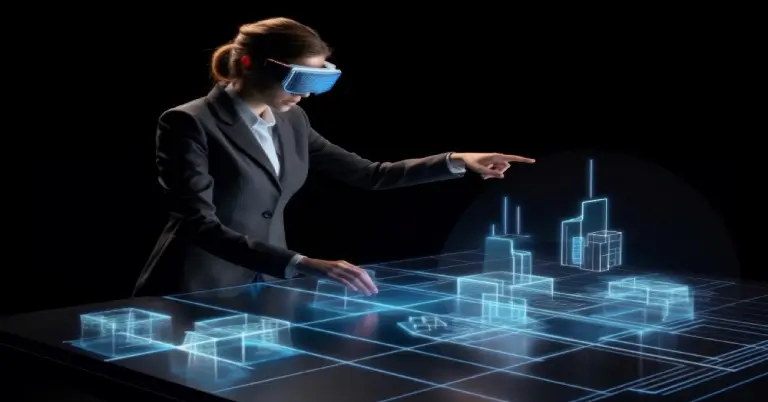If you want your audience to be mesmerized by your website, get advanced UI UX design services and experience the difference yourself!
As the frontend developmental realm evolves, user experience (UX) and user interface (UI) designs are becoming critical aspects of software development to deliver unique, appealing, and engaging usability to consumers, ensuring the success of digital products, websites, and software applications.
User Experience (UX) Design:
UX design encompasses the overall interactiveness and meaningfulness of a product. Visiting a website or a software application, the first thing you notice is the usability and the effortless usability that offers a highly pleasant and relatable user experience.
UX designers construct software products that are meaningful and offer relevant experiences including understanding the user requirements, needs, preferences, and search behaviors.
User Interface (UI) Design:
UI designers are solely responsible for the visual attractiveness and interactiveness of the software product.
The UI designs include icons, buttons, typography, colors, and responsive designs. These designs are aimed to be aesthetically pleasing, and eye-catching with smooth fluidity, accessibility, and user-friendly properties.
As UX designs focus on the user experience and understanding the user requirements, UI designs enhance the overall look, interactiveness, and responsiveness of the software web and apps.
Both UI/UX designers target excellent digital experiences for users while creating responsive, relevant, and adaptable features for software products that are also enjoyable to use.
Key Features of UX Design
1. Useful and User-friendly:
UX design is required to be adaptive to user needs and perform the functions the users need to do. In short, usability and convenience are the foremost features of an effective UX design.
2. Intuitive and Learnable:
UX designers being the front-end designers, ensure that the features are easily learnable. Users should be able to conveniently learn and navigate through the features.
3. Easy-to-Remember:
Developed adeptly, UX design needs to be easily memorable and accessible so even if the user comes back after inactivity, the features are easily understood and accessible.
Key Features of UI Design
1. Clarity:
Offering clarity and convenience is the essential purpose of the UI design of a software product, to help users understand and explore the software conveniently.
2. Responsiveness:
UI design services offer responsive software apps and websites to ensure fluid activity and performance, securing superb user experience.
3. Attractiveness:
UI designers usually make certain that the designs are eye-catching, pleasing, and relevant to the consumer. This plays a significant role in the success of a software product.
UI and UX designers strive to create successful digital products that are high-performing, functional, and attractive to use. UX design ensures that the overall experience is seamless and satisfying, according to consumer preferences. Meanwhile, UI design brings color to the product through visually appealing and intuitive interfaces.

Current Trends and Tech in UI UX Design Services
Integration of Advanced Technologies
UI/UX designers are now implementing futuristic technologies such as Artificial Intelligence (AI), Machine Learning (ML), and Augmented Reality (AR) to further advent in the software industry leveraging next-gen tools and delivering visionary results.
These tech and tools allow for more personalized and adaptive user experiences. For example, AI can help predict user behavior and preferences, hence helping designers develop customized, interactive interfaces.
Minimalistic and Clean Designs
Currently, minimalism is dominating designs especially UI/UX designs that need to be interactive and attractive.
Clean, simple, and easily navigatable interfaces and displays are preferred as they enhance usability and focus users’ attention on essential elements. Designers utilize simple typography, neutral and limited color palettes, and appropriate white spaces.
Microinteractions
Similar to minimal designs, Microinteractions are also popular in UI UX design presently. These are subtle, pleasing, and eye-catching, offering enhanced user experience. These interactions such as a button changing color when hovered over, or a smooth animation/sound when an action is completed are what make the software product highly interactive and delightful to users.
Accessibility and Inclusivity
One of the prominent requirements of UI/UX design is accessibility and inclusivity, creating relevant, preferred, and adaptive interfaces to enhance user satisfaction.
This involves adhering to accessibility standards and guidelines, such as the Web Content Accessibility Guidelines (WCAG), and designing with inclusivity in mind from the outset.
Mobile-First and Responsive Design
As mobile devices are much more popular in today’s age, UI/UX designers now focus on designing mobile-first features that are suitable for all devices but run the most pleasantly charming on mobile devices.
Responsive designs are made sure to work seamlessly across a variety of devices and screen sizes. This trend provides a consistent and optimal user experience, whether users are accessing an application on a smartphone, tablet, or desktop.
Voice User Interfaces (VUI)
Besides device responsiveness, there are more elaborate technological adaptations such as VUIs. UI/UX designs are now being integrated with Voice User Interfaces (VUI), where the software products respond and react to spoken voice commands, providing an effortless, typeless user experience that builds interest in the product.
Design Systems and Consistency
UI/UX designers are leveraging design systems and platforms that ensure consistency, standards, and guidelines for developers to follow. Besides, design systems also include components like color schemes, typography, and interaction patterns, streamlining the entire process and maintaining a cohesive identity.
Emotional Design
Emotional design focuses on creating experiences that evoke positive emotions and connect with users on a deeper level. This trend involves using design elements such as color, typography, and imagery to elicit specific emotional responses. By considering the emotional impact of their designs, UI/UX professionals can create more engaging and memorable user experiences.
Future Trends in UI/UX Design
1. AI-Driven Design
AI and machine learning adaptations in UI UX designs have improved the deliverables significantly offering a more personalized user experience through accurate behavior and preference analysis.
This helps create interfaces that adapt in real-time to meet individual needs, creating a more engaging and efficient user journey.
2. Voice and Conversational UI
With the progression of technology, the implementation of voice and conversational UI has become more prominent and helps users interact and access software products using the natural language without much effort.
Enhanced by AI, chatbots and virtual assistants will become more advanced, providing users with efficient and human-like interactions for customer service, information retrieval, and task management.
3. Augmented Reality (AR) and Virtual Reality (VR)
AR and VR will offer immersive experiences that blend the digital and physical worlds. UI/UX Designers will need to create intuitive and engaging interfaces to match the pace considering spatial design and user interactions.
AR and VR technologies will also be used in the design process itself, allowing designers to create and test prototypes more interactively and realistically.
4. Motion Design and Microinteractions
Motion design will play a critical role in making interfaces more dynamic and engaging. Subtle animations and transitions will guide users through interactions, provide feedback, and enhance the overall user experience.
These small, often overlooked design elements will become more sophisticated, providing users with immediate and contextually relevant feedback, and making interactions smoother and more enjoyable.
5. Ethical and Inclusive Design
The future will see a stronger emphasis on accessibility, ensuring that digital products are usable by people with diverse abilities. This will involve adherence to accessibility standards and the use of inclusive design practices.
Ethical Considerations: Designers will prioritize ethical considerations such as user privacy, data security, and transparency. Creating trustworthy interfaces will be paramount in building user confidence and loyalty.
6. Sustainable Design
Eco-Friendly Practices: As environmental concerns grow, sustainable design practices will gain importance. This includes designing energy-efficient interfaces, reducing digital waste, and promoting environmentally responsible user behaviors.
7. Multi-Device Experiences
Cross-Platform Consistency: Users increasingly interact with digital products across multiple devices, from smartphones and tablets to wearables and smart home devices. Ensuring a consistent and seamless experience across these platforms will be a key focus for designers.
8. Data-Driven Design Decisions
Analytics and User Feedback: The use of analytics and user feedback will become more sophisticated, allowing designers to make informed decisions based on real user data. This will lead to more effective and user-centric designs.
9. Remote and Collaborative Design Tools
Virtual Collaboration: With the rise of remote work, collaborative design tools will evolve, enabling seamless teamwork across different locations. These tools will support real-time collaboration, version control, and integrated feedback mechanisms.
Evaluating the Future of UI/UX
The future of UI/UX design is poised to be shaped by a combination of advanced technologies, evolving user expectations, and a heightened awareness of ethical and sustainable practices. Here’s an evaluation of these future trends:
1. Enhanced User Experience
The integration of AI, AR, VR, and motion design will lead to richer and more immersive user experiences. Personalized and adaptive interfaces will make interactions more intuitive, efficient, and enjoyable, fostering deeper engagement and satisfaction.
2. Greater Accessibility and Inclusivity
The focus on ethical and inclusive design will ensure that digital products are accessible to a broader audience, including people with disabilities. This will democratize technology, making it usable and beneficial for all users.
3. Sustainability as a Core Value
Sustainable design practices will align with the global movement towards environmental responsibility. Designers will need to balance functionality and aesthetics with eco-friendly considerations, contributing to a more sustainable digital future.
4. Interconnected Ecosystems
As multi-device experiences become more prevalent, designers will need to create cohesive ecosystems that provide seamless transitions between different devices. This interconnected approach will enhance user convenience and productivity.
5. Data-Driven Insights
The use of analytics and user feedback will lead to more precise and effective design decisions. By understanding user behavior and preferences, designers can create more targeted and impactful solutions that meet real user needs.
6. Remote Collaboration and Flexibility
The evolution of remote and collaborative design tools will enable greater flexibility and creativity in the design process. Teams will be able to work together efficiently, regardless of their physical location, fostering innovation and diversity of thought.
Conclusion
UI/UX designing for accessibility is not just a trend but a crucial aspect of the future of UI/UX in web development. Developers can create digital experiences that are accessible to everyone, aesthetically pleasing, and inclusive. This approach not only enhances user satisfaction but also broadens the reach and impact of web applications, making them more relevant in an increasingly diverse and connected world.
Now, with the breakthroughs in frontend development services, the entire UI UX experience has been upgraded for maximum interactive interfaces, visually exceptional products, and consumer satisfaction.
FAQs
Q1: What is the main purpose of UI UX?
UI and UX have a singular common purpose: to create a positive and engaging user experience. Both UI/UX designers aim to ensure that interacting with a product or service is seamless, efficient, and enjoyable. In both disciplines, the user remains the focal point throughout the design process.
Q2: What are the benefits of UI/UX?
Here are the benefits of UI/UX designs:
- Lower development costs.
- Enhanced customer/user loyalty.
- Strengthened long-term relationships.
- Attraction of new clients.
- Improved conversion rates.
- Ability to command higher prices.
- Greater return on investment.
Q3: Which software is used for UI/UX design?
Adobe is a leader in design software, and its presence in the UI/UX design space is no exception. Adobe XD is their dedicated tool for UI/UX designers, providing vector-based UI tools ideal for creating prototypes and mockups.
Q4: Why are UI/UX designs important?
Offers a Competitive Edge
In today’s highly competitive digital environment, effective UI/UX design is a key differentiator. A user-friendly and visually appealing design distinguishes a product, making it more attractive to potential customers and influencing their decisions.
Q5: What language is used in UI UX design?
HTML, CSS, and JavaScript
You can leverage a range of libraries and frameworks built on these technologies to enhance your UI and UX design, including Bootstrap, jQuery, React, Angular, and Vue. These tools offer pre-built components, templates, and functions that streamline and accelerate the development process.











